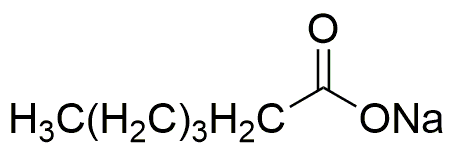Sodium hexanoate is widely utilized in research focused on:
- Food Preservation: As a food additive, it acts as a preservative by inhibiting the growth of mold and bacteria, enhancing shelf life in products like baked goods and dairy.
- Biotechnology: Used in microbial fermentation processes, it serves as a carbon source, promoting the growth of specific microorganisms for the production of enzymes and biofuels.
- Agriculture: Employed as a biopesticide, it helps control pests and diseases in crops, providing an eco-friendly alternative to synthetic chemicals.
- Pharmaceuticals: In drug formulation, it can enhance solubility and stability of active ingredients, improving the efficacy of medications.
- Cosmetics: Utilized in personal care products, it acts as a surfactant and emulsifier, improving texture and consistency in creams and lotions.
General Information
Properties
Safety and Regulations
Applications
Sodium hexanoate is widely utilized in research focused on:
- Food Preservation: As a food additive, it acts as a preservative by inhibiting the growth of mold and bacteria, enhancing shelf life in products like baked goods and dairy.
- Biotechnology: Used in microbial fermentation processes, it serves as a carbon source, promoting the growth of specific microorganisms for the production of enzymes and biofuels.
- Agriculture: Employed as a biopesticide, it helps control pests and diseases in crops, providing an eco-friendly alternative to synthetic chemicals.
- Pharmaceuticals: In drug formulation, it can enhance solubility and stability of active ingredients, improving the efficacy of medications.
- Cosmetics: Utilized in personal care products, it acts as a surfactant and emulsifier, improving texture and consistency in creams and lotions.
Documents
Safety Data Sheets (SDS)
The SDS provides comprehensive safety information on handling, storage, and disposal of the product.
Product Specification (PS)
The PS provides a comprehensive breakdown of the product’s properties, including chemical composition, physical state, purity, and storage requirements. It also details acceptable quality ranges and the product's intended applications.
Certificates of Analysis (COA)
Search for Certificates of Analysis (COA) by entering the products Lot Number. Lot and Batch Numbers can be found on a product’s label following the words ‘Lot’ or ‘Batch’.
*Catalog Number
*Lot Number
Certificates Of Origin (COO)
This COO confirms the country where the product was manufactured, and also details the materials and components used in it and whether it is derived from natural, synthetic, or other specific sources. This certificate may be required for customs, trade, and regulatory compliance.
*Catalog Number
*Lot Number
Safety Data Sheets (SDS)
The SDS provides comprehensive safety information on handling, storage, and disposal of the product.
DownloadProduct Specification (PS)
The PS provides a comprehensive breakdown of the product’s properties, including chemical composition, physical state, purity, and storage requirements. It also details acceptable quality ranges and the product's intended applications.
DownloadCertificates of Analysis (COA)
Search for Certificates of Analysis (COA) by entering the products Lot Number. Lot and Batch Numbers can be found on a product’s label following the words ‘Lot’ or ‘Batch’.
*Catalog Number
*Lot Number
Certificates Of Origin (COO)
This COO confirms the country where the product was manufactured, and also details the materials and components used in it and whether it is derived from natural, synthetic, or other specific sources. This certificate may be required for customs, trade, and regulatory compliance.

